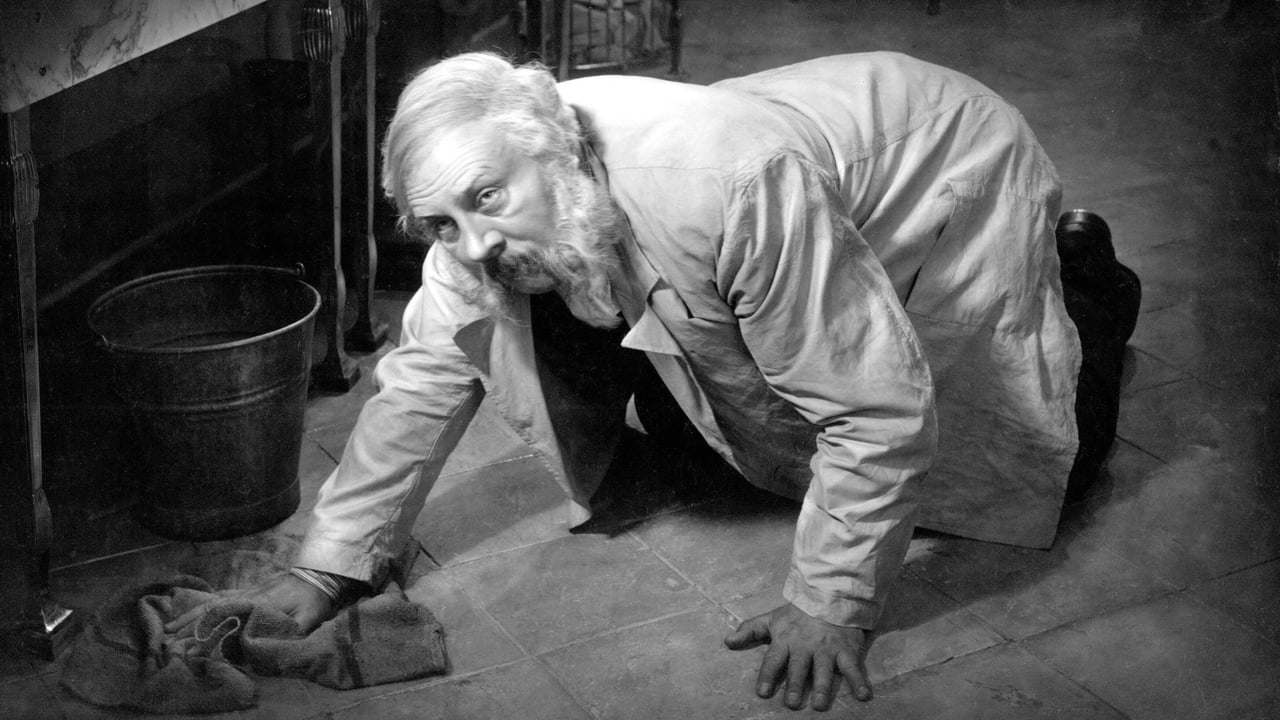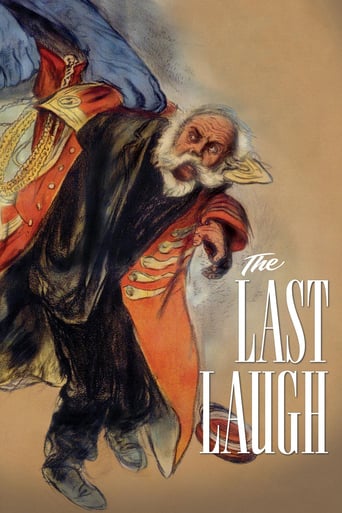



Some things I liked some I did not.
Gripping story with well-crafted characters
Absolutely amazing
All of these films share one commonality, that being a kind of emotional center that humanizes a cast of monsters.
View MoreYep. It's about a doorman. A fat, pompous doorman. A doorman that, because he's getting old, get's demoted to Washroom Attendent. Then he does washroom things. Sounds dry, but it's not.Emil Jannings play the lead (did I mention, doorman?). He carries the entire film in a masterful silent performance. Truly silent; not one dialog card in the entire movie.Direction, camera-work and lighting are all excellent.Could've been a masterpiece if not for a ridiculous deus ex machina ending. Not just a "didn't see that coming" ending, but a ending that is just absurd enough to ruin the integral mood of the first 80 minutes.If you like classic silents you should check this out. But you will leave unsatisfied if you want an emotional payoff.
View MoreThe film is among the finest achievements of the silent cinema. The old doorman (Emil Jannings) of a luxury hotel is demoted to the job of lavatory attendant, but comes into a fortune and gets his revenge.The Last Laugh is an ironic silent anecdote, made important by its virtual abandonment of dialogue and the whole-hearted adoption of a freewheeling camera technique which gives some thrilling dramatic effects. The film is the most famous example of the short-lived Kammerspiel or "chamber-drama" genre. The set was built entirely within a studio, unusual for director F.W. Murnau, who preferred to shoot on location.
View MoreF.W. Murnau, along with compatriot Fritz Lang, was and remains one of the most influential German directors of all time, his surviving work including 'Nosferatu, eine Symphonie des Grauens (1922),' 'Faust (1926)' and 'Sunrise (1927)' {the latter of which I have regrettably not seen yet} continuing to inspire new generations of film-goers and filmmakers more than eighty years later. In 1924, Murnau released what it often held as one of his masterpieces, 'The Last Laugh' {though the director's original title was 'The Last Man'}. However, in no small part due to the interference of Universum Film (UFA) Studio, I must admit that I found this effort to be slightly underwhelming, an unfortunate result for a motion picture that I had felt sure I'd adore. Frequent collaborator Emil Jannings is undoubtedly the star of the film, occupying almost the entire screen time, and playing the character about whom the story revolves. Performing with a passion that transcends the technical boundaries of the silent film, Jannings gives a truly heart-breaking performance that is worth the price of admission alone.'The Last Laugh' was the newest addition to a short-lived movement of film-making known as Kammerspiel, or "chamber-drama," which often concerned itself with the lives of the working-class, and rarely used intertitles to create spoken dialogue or narration. I found myself likening the style to that of the Italin neo-realism movement, if only for showing an average, not-particularly-important man overwhelmed by the cruelty of upper-class society. However, several scenes diverge from this mould, most specifically a dizzying, wondrous dream sequence, and a tacked-on optimistic ending imposed by the commercially-insecure studio. Though it was not the first film to exploit a moving camera, I've rarely seen a silent film making better use of the technique. The camera, with no small thanks to cinematographer Karl Freund {who went on to work on such American films 'All Quiet on the Western Front (1930)' and 'Key Largo (1947)'}, swoops gracefully through Murnau's specially-constructed sets, an effect that is both invigorating and captivating. In one ingenious sequence, the camera even passes through a glass window to achieve a close-up of our protagonist.Hints of German Expressionism {in which Murnau had dabbled in previous years} are also easily noticeable, most notably in the entrancing dream sequence, in which a feverish hand-held camera captures Emil Jannings fancifully holding a hefty trunk high above his head, hurling it an impossible distance into the air and then catching it again with an outstretched arm. Also worth mentioning is a brief scene in which the downcast hotel porter, ashamed at having lost his prestigious job, imagines the tall building collapsing on top of him, representative of the enormous pressure that he feels has been thrust upon his life and respectability. The sneering collection of low-life gossipers, each sporting ridiculous sly grins of mischievous satisfaction, have a tendency to get annoying after a while, and I'd much rather be spending that time with Jannings' warm, kind and quietly proud hotel porter, even if his happy ending {introduced with an openly sardonic intertitle side-note from the director} is more of a crushing disappointment than anything else.
View MoreThis is such a great- and even better told story. It features normal average persons who get in some realistic difficulties and struggle with life. You can just feel how heartbroken the old man is after loosing his job and the respect he had among the community because of his uniform. Yeah, uniforms were still a that big thing at that time. The movie especially does a good job with showing the contrasts between the 'two worlds', of money and respectability and poor and being just considered average, or even less. It makes "Der Letzte Mann" such a powerful and effective movie!I love it when a silent movie doesn't use too many or hardly any title cards. Just let the images tell the story. It takes a great director to do this but F.W. Murnau was obviously one of the best, not just of his time but of all time!The movie is filled with some greatly made and looking memorable sequences, such as a couple of great dream-like- and surrealistic sequences. In those sequences it becomes once all the more obvious how great of a director F.W. Murnau was.The movie is filled and even more uplifted by its fantastic camera-work! I love it when old movies use early movement-effects and pans and zooms, though obviously the movie doesn't use this all the time. Especially the beginning is memorable, when the movie opens with one of the first ever hand-held camera shots. It's different from the normal usual static camera-work from the '20's and '30's. But also the lighting of the movie is absolutely phenomenal. It gives the movie such a good, warm and effective powerful look. The same goes for the fast and nimble editing and compositions, that make the story flow extremely well. Old movies normally feel distant because of the old fashioned style and look. But not this one!The movie was obviously mostly shot at studios and the street sets look like they were made out of cardboard (which they most likely also were) but that is all part of the charm of these expressionistic German movies from the '20's, such as also "Metropolis", "Das Cabinet des Dr. Caligari" and "Faust".The make-up effects are perhaps an underrated aspect of the movie. I mean it's not a 'make-up' movie, such as "Nosferatu, eine Symphonie des Grauens" or "Faust" (both also directed by F.W. Murnau by the way) but remember that Emil Jannings was in his early 40's during this movie, though he truly looked like he was in his 60's or so. So some really effective and convincing make-up effects here! If you didn't knew any better you would just think that this movie had a 60 year old playing the main character.A great, powerful- but also beautiful movie experience, from F.W. Murnau!10/10http://bobafett1138.blogspot.com/
View More